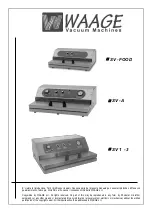
8
For Best Performance
1.
Do not overfill a bag; leave 5cm of empty
space at the open end of the bag so that it
can be placed in the vacuum chamber area
without creating wrinkles or ripples
2.
Do not wet the open end of the bag as this
will affect the ability to heat seal the bag
3.
If bags do not seal properly, check:
A. Bag does not have a hole or any
other damage
B. Lower gasket on appliance is positioned
correctly and not damaged
4.
Clean and straighten the open end of the
bag before sealing
5.
When vacuum sealing food or items that
have sharp points, cover these with paper
towel to ensure bag is not damaged
6.
If air has escaped from the bag, check the
seal on the bag
7.
Clean appliance thoroughly after each use
Food Safety
•
Vacuum packaging is
NOT
a substitute
for refrigeration or freezing. Any food
that requires refrigeration must still
be refrigerated or frozen after vacuum
packaging
•
To avoid possible illness,
DO NOT
reuse bags
•
Ensure vacuum chamber and appliance
are clean before use
•
Ensure your hands, utensils and surfaces
being used are clean before vacuum
sealing
•
Refrigerate or freeze perishable foods
immediately after vacuum sealing
•
Vegetables such as broccoli, cauliflower
or cabbage emit gases when
refrigerated. Blanch or freeze these
vegetables before vacuum sealing
•
Some fruits and vegetables, such as
apples, bananas or potatoes, will have
longer shelf lives if they are peeled
before vacuum sealing
•
Factors such as temperature, moisture,
acidity, salt or sugar content in foods
may influence the growth of
micro-organisms which may
be potentially harmful
Summary of Contents for 10000494
Page 2: ...2 ...
Page 5: ...5 J L N A M J I H C D B E F G I O K P 240V AC 12V DC ...
Page 14: ......
































